Steel Is Stronger Than Concrete?
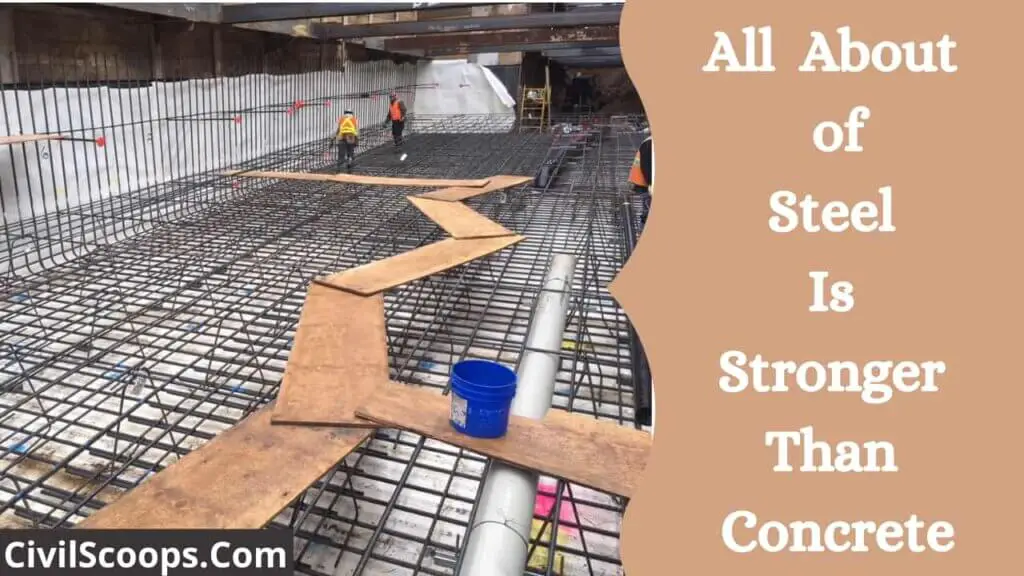
Table of Contents
Introduction of Steel Is Stronger Than Concrete
Because concrete has a greater compressive strength than steel, steel bars are utilised in concrete to accommodate tension stresses due to the concrete’s weakness. The concrete wall alone is far more powerful than the steel mass.
Concrete buildings have significant safety advantages over steel structures. Concrete provides great explosion protection and can withstand extremely high temperatures for extended periods of time. Concrete structures are quick to construct and appealing.
Steel is also an option for big parts, but it takes more time and money to design, and the cost of insuring a steel structure is more than that of a concrete building due to variations in safety. Steel is increasingly widely utilised for environmental protection and reinforcing.
When it comes to building design, steel provides a wider range of alternatives. Steel has a higher weight strength than other construction materials.
Concrete is extraordinarily strong under compression, but it has no strength when tensioned; for this reason, rebar is utilised in concrete to provide it the capacity to withstand tensile stresses.
Reinforced concrete with steel is a better building material than concrete and steel alone. Concrete constructions can withstand compressive forces, but not tensile strains.
Difference Between Steel and Concrete
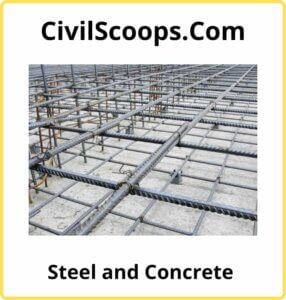
Steel used to make rolled steel structure, fastenings, and other parts for use in structural steel works is referred to as structural steel. The Indian Standard Institution (I.S.I.) has standardised structural steel for use in construction, and specifications for various quality are given in the following standards (as per I.S 800-1984)
After water, concrete is the second most often utilised construction material on the planet. Concrete structures can withstand compression loads well, but they cannot withstand tensile loads. As a result, when the structure is under strain, reinforcement is added to the concrete. Because of its durability and compatibility, concrete is widely employed in the building sector today. Furthermore, concrete can be moulded into any shape, making it extremely versatile.
Concrete Construction Costs
The cost of concrete construction is influenced by a number of factors, including the concrete grade, the cost of supplies such as formwork, reinforcing steel, labour, and finishing.
In addition to significant losses, these costs harm the contractor, the owner, or both.
Steel Vs Concrete
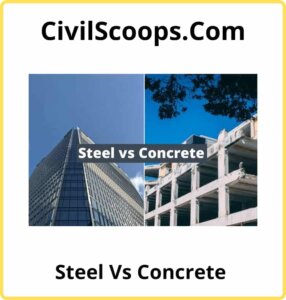
1. Strength
- Steel structure is a strong, rigid, ductile, and robust material that is widely utilised in industrial and commercial building construction.
- Concrete is a substance made up of sand, water, gravel, and cement. Although the concrete has a higher compressive strength, it has a poor tensile strength. Concrete must be reinforced with steel to enhance the structure’s tensile capacity, elasticity, and ductility.
2. Fire Resistance
- Steel is a non-combustible material whose strength may be drastically reduced when subjected to high pressure. Steel must be coated with fire-resistant materials to increase safety.
- Because of the nature of concrete, it is naturally fire-resistant. When concrete is utilised for building construction, many of the other components are not fire-resistant. Professionals should be familiar with all of the safety standards in order to avoid issues within the overall structure.
3. Sustainability
- Because 90% of steel structures are made from recycled steel, and steel constructions are 100% recyclable. Because of its lengthy lifespan, steel may be changed several times without compromising structural integrity. When constructed, the steel structure will have the least amount of environmental effect since it is carefully produced and handled.
- Concrete is natural to our environment; it may be broken and utilised in various combinations, reducing the amount of concrete in landfills.
4. Versatility
- Steel is a versatile material for countless uses and may be produced in a wide range of designs. Steel gives several aesthetic possibilities which much higher materials and the strength to weight ratio than other materials
- Concrete may be shaped into various forms and it has some restrictions when it comes to the floor to the floor and the log building heights.
5. Corrosion
- When in contact with water steel it may corrode, and if left without adequate maintenance, it may also damage structural safety and security. The treatment techniques are paint care and water resistance. Fireproof characteristics may be introduced when waterproof dyes are applied.
- Reinforced concrete is waterproof and does not contain sufficient care and structure, and it is crucial that the steel reinforcement within is never exposed to exposure.
6. Environmental consideration
- Using 90% of the steel recycled, steel is sorted with the magnets. The energy required for the manufacture of steel is increased at considerable distances.
- Often locally produced concrete is necessary for shipment to areas with limited energy. Recyclicated steel rebar can be used for crushing and recycling of concrete and concrete at end of life, however recycled material for new constructions cannot be utilised.
Also Read: Building Layout | How to Building Layout | Construction Layout Techniques
How Strong Is Concrete?
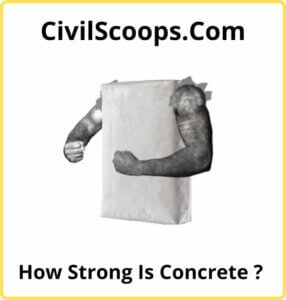
Strong enough concrete to carry a 3,000 psi compressive load in 28 days. Concrete can also be chosen for different forces. The strength of conventional concrete is 7000 psi or less; the strength of concrete is called high strength concrete between 7,000 and 14,500 psi.
Steel and Concrete Construction
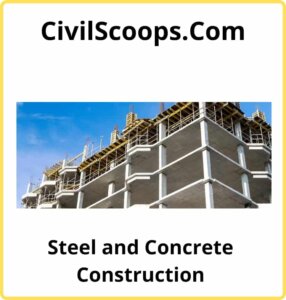
Concrete Construction
- Concrete is the second most often used building material, after water, since it is versatile, durable, and easy to fabricate, and it can be moulded into any shape. Concrete constructions are extremely resistant to compression, yet they are unable to efficiently withstand tension.
- As a result, most concrete structures are reinforced with steel bars to offer extra tensile load support, and this combination is referred to as reinforced concrete. Concrete buildings may be constructed in a variety of ways and using various kinds of concrete. Plain cement concrete, reinforced concrete, and prestress concrete are the three most popular varieties.
- Plain cement concrete is made by blending cement, coarse aggregate (gravel), fine aggregate (sand), and water in the proportions specified by the designer. When these materials are hardened, they form a homogenous mass. Plain cement concrete structures have a high compressive strength but essentially little tensile strength.
- As a result, because these constructions are subject to compressive stresses, plain cement concrete is usually employed in roadways and concrete blocks for walls.
- Reinforced concrete is essentially normal cement concrete reinforced with steel bars that enhance tensile strength. This is the most popular form of concrete used in construction, with uses ranging from houses to structures such as water tanks.
- Prestressed concrete is preloaded before it is subjected to any load other than its own weight by adding compressive stress. Before applying external loads, high-strength steel tendons are tensioned within the concrete volume to induce compression. This increases its performance once it is put into service.
Steel Construction
- Steel is a composite material made up of iron, carbon, and other components. It is classed as mild steel, medium carbon steel, high carbon steel, low alloy steel, or high alloy steel based on its chemical composition.
- Structural steel is a kind of steel utilised in the building sector, as its name suggests. Standards such as those set out by the American Institute of Steel Construction control the forms and qualities of structural steel (AISC).
- Elongated beams with a specified cross section make up the majority of structural steel forms.
- The I-beam is the most common form, and it is highly stiff in terms of cross-sectional area. As a result, it can withstand heavy weights without deforming.
Also Read:What Is Plastering | What Is Pointing | Difference Between Plastering and Pointing |
Concrete Vs Steel Building Cost
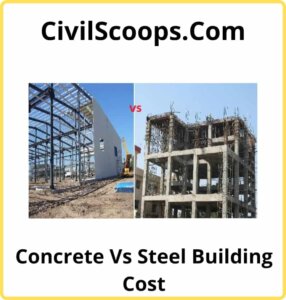
1. Cost of Materials
- Concrete prices are consistent, and concrete components are generally affordable and readily available.
- Steel’s greatest hidden secret is its affordability. Steel has the best strength-to-weight ratio of any construction material. It produces a considerably stronger structure while utilising significantly less material. As a result, the cost is reduced.
- The majority of the steel used by Simpson Steel Building Company is recycled, which helps to explain why the cost is so low. Almost all wasted steel products are collected for recycling by the steel industry scrap collecting system. Steel prices, as a result, have remained largely stable throughout time.
2. Cost of Construction
- Concrete building may be time-consuming and labor-intensive, necessitating the use of a qualified contractor and crew to get the finest results. You must also wait for the concrete to cure completely. This increases building time, resulting in greater building costs.
- Simpson Steel Buildings uses much less steel in its construction. Our structures are both prefabricated and pre-engineered. This significantly reduces building time and costs. To complete the prefabricated frame correctly, a smaller, less experienced staff is required.
3. Long-Term Costs
- When selecting construction materials for your structure, make sure you consider the long-term expenditures as well. Concrete structures limit temperature fluctuations and draughts, saving money on heating and cooling, but they also need ongoing maintenance and repair.
- Steel buildings retain their worth for decades with little to no upkeep. Steel buildings do have energy efficiency concerns, however adding an insulation package to your structure will readily solve the problem. Adding insulation to your steel structure will help you save money on heating and cooling.
Recycle-ability

Steel structures are the most environmentally friendly option if you are also concerned about the environment.
While concrete may be recycled once it has served its purpose, it cannot be utilised for new construction. Recycling is likewise not economically viable. This means that nearly half of the concrete used in building is recycled. The remainder is disposed of in landfills.
Steel is the only material that keeps all of its strength regardless of how many times it is recycled. As a result, it may be utilised again. Almost entirely of all structural steel is recycled. Steel recycling is less expensive than steel production.
If you ever decide to demolish your structure, you’ll have to hire someone to come and remove the concrete ruins. However, scrap merchants will pay you for all of your steel frame during deconstruction.
[su_box title=”FAQ” style=”default” box_color=”#333333″ title_color=”#FFFFFF” radius=”3″ class=”” id=””]
Steel Concrete
Steel-reinforced concrete is meant to use the compressive strength of concrete with the tensile strength of steel to carry heavy loads, such as footings, foundation walls, and columns. Driveways with heavy traffic, carport floors, and large shed floors may also require reinforced concrete to support the weight.
Slab Reinforcement
Structural reinforcement is typically placed in the bottom portion of the slab thickness to increase the slab’s load capacity. Most structural slabs-on-ground have both top and bottom layers of reinforcement for controlling crack-widths and increasing load capacities.
Reinforced Concrete Rebar
Rebar (short for reinforcing bar), known when massed as reinforcing steel or reinforcement steel, is a steel bar or mesh of steel wires used as a tension device in reinforced concrete and reinforced masonry structures to strengthen and aid the concrete under tension.
Rebar Foundations
Using rebar in concrete footings will make it stronger and less resistant to shifting due to temperature and humidity. Concrete is the construction material of choice for footings because of its compression strength. However, it is not strong when subjected to forces that pull – such as shifting earth.
Rebar Bars
Steel reinforced-bar is most regularly utilized as a tensioning devise to fortify concrete and other workmanship structures to hold the concrete in a compacted state. Rebar is the short form of reinforcing bar. It is also known as reinforcing steel or reinforcement steel.
Rusted Rebar Treatment
- Wire brush to remove all loose rust and paint.
- Apply two or three coats of our ultra rust cure seal – owatrol oil – apply until surface looks glazed.
- Apply two coats of ultra rust stop primer – owatrol primer.
- Apply two coats of our deco finish coat in grey – owatrol deco finish.
Steel Bars for Concrete Reinforcement
Steel reinforcement bars or rebars are used to improve the tensile strength of the concrete, since concrete is very weak in tension, but is strong in compression. Steel is only used as rebar because elongation of steel due to high temperatures (thermal expansion coefficient) nearly equals to that of concrete.
Reinforcement Beams
Reinforced concrete beams are structural elements that designed to carry transverse external loads. The loads cause bending moment, shear forces and in some cases torsion across their length. Moreover, concrete is strong in compression and very weak in tension.
Rebar Cement Slab
Rebar is not necessary for every concrete project. The general rule of thumb is that if you are pouring concrete that is more than 5 inches in depth, you are probably going to want to add in some rebar to help reinforce the entire structure.
Reinforcing Bar
Rebar is a steel bar that is used in concrete construction. By adding these reinforcing steel bars, you’re creating reinforced concrete. Whether your project includes floor slabs, walls or posts, rebar helps keep cracks that form from making the project fall apart.
[/su_box]
[su_note note_color=”#F2F2F2 ” text_color=”#333333″ radius=”3″ class=”” id=””]
Like this post? Share it with your friends!
Suggested Read –
- Information About Contractor
- What Is Fresh Concrete? | Properties of Fresh Concrete | Factors Affecting Workability
- What Is Heat Resistance Concrete? | Reinforcement in Heat Resisting Concrete | Properties of Heat Resisting Concrete | Application of Heat Resisting Concrete | Advantages & Disadvantages of Heat Resisting Concrete
- What Is Traffic Rotaries? | Rotary Intersection | What Is Rotary Island? | Advantages & Disadvantages of Traffic Rotary
- What Is Development Length | Why We Provide Development Length | How to Calculate Development Length | Development Length for Single Bars
[/su_note]
Originally posted 2024-04-05 05:14:00.
